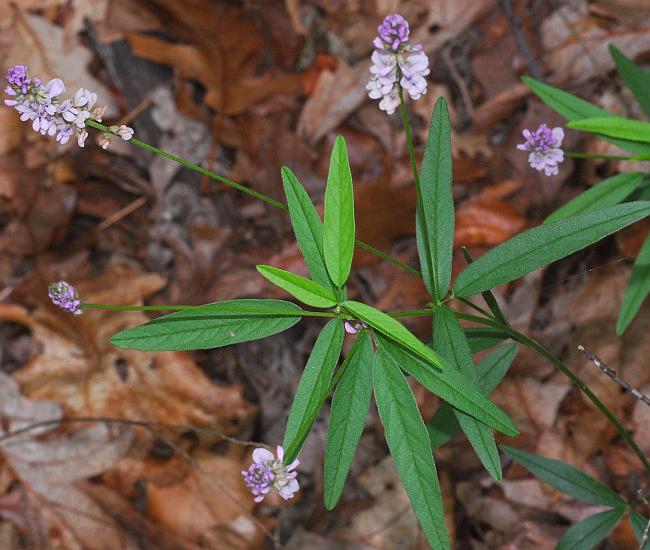Orbexilum pedunculatum (Mill.) Rydb.
Sampson's Snakeroot

Native
CC = 6
CW = 3
MOC = 57
© DETenaglia
Orbexilum pedunculatum (Mill.) Rydb.Sampson's Snakeroot | |
 |
Native CC = 6 CW = 3 MOC = 57 |
© DETenaglia |
|
Family - Fabaceae/Faboideae Habit - Perennial forb with woody taproots thickened toward the tip, not colonial, but the stems frequently 2 to several from the base, appearing clumped. Stems - Ascending to erect, to 70 cm, multiple from base, green to tan at the base, unbranched or less commonly few-branched above the base, moderately to densely pubescent with short, strongly upward-curved to appressed hairs toward the tip, often also inconspicuously gland-dotted, more sparsely hairy or sometimes nearly glabrous toward the base.
Leaves - Alternate, pinnately trifoliate, petiolate, stipulate, the petioles of well-developed leaves 0.5-5.0 cm long, the terminal leaflet with the stalk 6-10 mm long. Stipules 3-5 mm long, linear to hairlike, those subtending well-developed leaves erect or ascending. Leaflets 2-7 cm long, 0.5-1.8 cm wide, narrowly elliptic to narrowly elliptic-lanceolate, the terminal leaflet similar in width but sometimes slightly longer than the lateral leaflets, rounded to bluntly pointed at the tip, the upper surface glabrous or more commonly sparsely to densely and loosely appressed-hairy, often also sparsely and inconspicuously gland-dotted, the undersurface not or only slightly lighter than the upper surface, moderately to densely hairy, not gland-dotted.
Inflorescence - Dense axillary spikelike racemes 2-12 cm long, elongating with age, the stalk 4-14 cm long, antrorse strigose, the bracts 4-7 mm long.long, antrorse strigose.
Flowers - Calyces short-hairy, the tube 1.0-1.5 mm long, the lobes 1-3 mm long, the lowermost lobe longer than the upper lobe, sharply pointed. Corollas papilionaceous, lilac, drying tan, the banner 5-7 mm long, the wings 4.5-6.0 mm long, the keel 3-4 mm long. Filaments with the fused portion 2-3 mm long, the free portion 0.2-0.4 mm long, the anthers all similar and attached at the base.
Fruits - Legumes with the body 4-5 mm long, 3-4 mm wide, obliquely obovate in outline, short-tapered to a minute, strongly curved beak, the surface with a network of cross-wrinkles, but not warty, light brown to yellowish brown. Seeds 2.5-3.5 mm long.
Flowering - May - July. Habitat - Prairies, savannas, forests, edges of fens and ponds, streambanks, tops of bluffs, railroads roadsides. Often on acid soils. Origin - Native to the U.S. Lookalikes - O. onobrychis. Other info. - This attractive species is fairly common in the southern half of Missouri, rare or absent in the northern half. This line of demarcation extends beyond Missouri and defines the northwestern border of the plant's natural range, which extends to several southern states. The plant is easy to identify because of its lilac inflorescences and trifoliate leaves with narrow leaflets. The small, wrinkled fruits are also very distinctive. The inflorescences are the same in appearance as those of the plant's close relative O. onobrychis, but that species has much wider leaflets. Photographs taken on Bear Mountian, MO., 6-1-03 (DETenaglia); also at LaBarque Creek Conservation Area, Jefferson County, MO, 5-30-2011, and Little Lost Creek Conservation Area, Warren County, MO, 5-28-2014 and 6-10-2019 (SRTurner). |